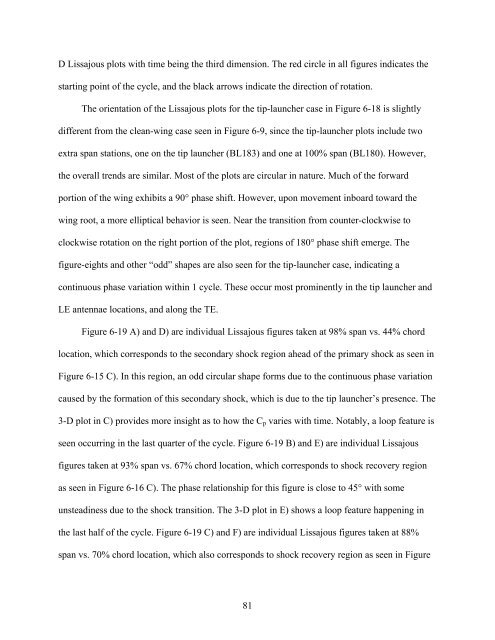university of florida thesis or dissertation formatting template
university of florida thesis or dissertation formatting template
university of florida thesis or dissertation formatting template
You also want an ePaper? Increase the reach of your titles
YUMPU automatically turns print PDFs into web optimized ePapers that Google loves.
D Lissajous plots with time being the third dimension. The red circle in all figures indicates the<br />
starting point <strong>of</strong> the cycle, and the black arrows indicate the direction <strong>of</strong> rotation.<br />
The <strong>or</strong>ientation <strong>of</strong> the Lissajous plots f<strong>or</strong> the tip-launcher case in Figure 6-18 is slightly<br />
different from the clean-wing case seen in Figure 6-9, since the tip-launcher plots include two<br />
extra span stations, one on the tip launcher (BL183) and one at 100% span (BL180). However,<br />
the overall trends are similar. Most <strong>of</strong> the plots are circular in nature. Much <strong>of</strong> the f<strong>or</strong>ward<br />
p<strong>or</strong>tion <strong>of</strong> the wing exhibits a 90° phase shift. However, upon movement inboard toward the<br />
wing root, a m<strong>or</strong>e elliptical behavi<strong>or</strong> is seen. Near the transition from counter-clockwise to<br />
clockwise rotation on the right p<strong>or</strong>tion <strong>of</strong> the plot, regions <strong>of</strong> 180° phase shift emerge. The<br />
figure-eights and other “odd” shapes are also seen f<strong>or</strong> the tip-launcher case, indicating a<br />
continuous phase variation within 1 cycle. These occur most prominently in the tip launcher and<br />
LE antennae locations, and along the TE.<br />
Figure 6-19 A) and D) are individual Lissajous figures taken at 98% span vs. 44% ch<strong>or</strong>d<br />
location, which c<strong>or</strong>responds to the secondary shock region ahead <strong>of</strong> the primary shock as seen in<br />
Figure 6-15 C). In this region, an odd circular shape f<strong>or</strong>ms due to the continuous phase variation<br />
caused by the f<strong>or</strong>mation <strong>of</strong> this secondary shock, which is due to the tip launcher’s presence. The<br />
3-D plot in C) provides m<strong>or</strong>e insight as to how the Cp varies with time. Notably, a loop feature is<br />
seen occurring in the last quarter <strong>of</strong> the cycle. Figure 6-19 B) and E) are individual Lissajous<br />
figures taken at 93% span vs. 67% ch<strong>or</strong>d location, which c<strong>or</strong>responds to shock recovery region<br />
as seen in Figure 6-16 C). The phase relationship f<strong>or</strong> this figure is close to 45° with some<br />
unsteadiness due to the shock transition. The 3-D plot in E) shows a loop feature happening in<br />
the last half <strong>of</strong> the cycle. Figure 6-19 C) and F) are individual Lissajous figures taken at 88%<br />
span vs. 70% ch<strong>or</strong>d location, which also c<strong>or</strong>responds to shock recovery region as seen in Figure<br />
81
















